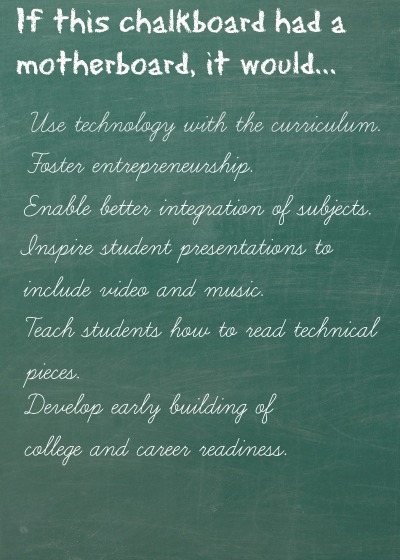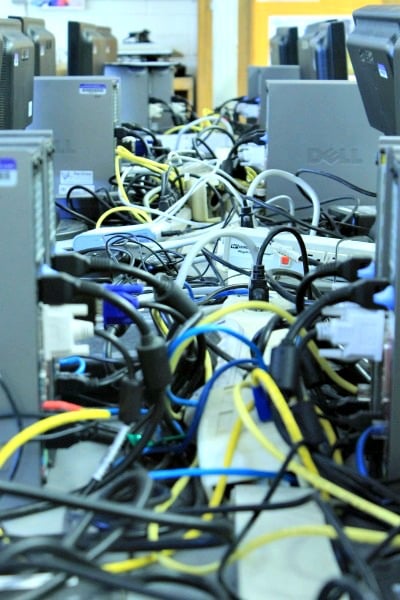 Most of us are not techno-geeks or a technology wizards, but can appreciate the ability to sit on our couches, watch TV and check email, pay bills, surf Facebook or have a Facetime chat with family far away, all at the same time. For most of us, our wireless world looks like the one described here, but what it means in our schools is something entirely different.
Most of us are not techno-geeks or a technology wizards, but can appreciate the ability to sit on our couches, watch TV and check email, pay bills, surf Facebook or have a Facetime chat with family far away, all at the same time. For most of us, our wireless world looks like the one described here, but what it means in our schools is something entirely different.
Last fall, in a meeting with Charlie Miller, Verona’s director of curriculum, I learned that educational apps and wireless access are not as prevalent in school as they are at home. Until that moment, it had seemed to me that the network we had was just fine: Grades are posted online, parents can email teachers and the district-wide announcements successfully land on our phones and in our email inboxes. What more was needed?
As we discussed wireless technology in the classroom, Miller told me about a sixth grade science teacher who was using iPod Touches to test her students helping them (and her) identify trouble spots before a test. As a regular app user, I thought that seemed like a very cool tool. As a parent, my immediate question was why is my daughter, who is in 6th grade, not benefitting from that approach. “How,” I asked Miller, “do we get more teachers to do the same?”
The answer is training and technology. Verona’s public schools have not had training workshops on incorporating technology into traditional subject areas or the classroom in general. But even if they had been trained, our teachers couldn’t all use iPod touches or iPads every day in every classroom because the network isn’t strong enough to handle that many users and wireless devices at one time. Verona’s network is 10 years old, an astounding age in tech terms. The $889,086 earmarked for technology in the $13.8 million referendum could change that.
At Verona High School, where the computer backbone is housed, teachers rig wireless routers for their needs and hope the network doesn’t crash like it did over the summer when Chris Tamburro’s students lost two months of history research that had been stored on the district’s server. That crash cost the district $25,000.

Tamburro (a history and social sciences teacher) and Rich Wertz (VHS computer sciences and math teacher) believe that students are more engaged in the classroom when technology is introduced as a method to teach.
“Verona teachers have done so well with what they have and stretched every resource,” says Tamburro. “They are motivated, young, and aggressive, striving to move teaching to the current level.”
For Tamburro, wireless access across the district would allow students to do research online while in the classroom and openly discuss the results in real time. Ideally, this wired wireless environment gives students an active voice inviting group discussion and gives teachers a platform for discussion. It captures the students attention because it’s new and encourages collaboration. Additionally, students learn that handheld devices like their phones can be used for more than Snapchat, Instagram, Twitter and Facebook. Even better, many of the educational apps are free.
A strong wireless network isn’t just about students using iPod Touches and iPads in the classroom. It’s also about taking the computer sciences curriculum to the next level, and not just for students strong in math. There are many students who benefit more than others in technology classes, specifically the ones who would otherwise be lost. Given the level of interest among students using handheld devices in the classrooms, this was not surprising. Students who struggle with the traditional classes of world language, literacy, or math, and don’t like coming to school, have found a home in computer programming. Whether visually stimulating, less intimidating, or more diverse in applications, these students thrive on computer classes; some have even found early motivation to become architects or programmers. Computer classes have, says Wertz, “created awareness of a path where students can excel beyond traditional classes. Students have attained unexpected success driven by their own interest.”
Wireless, a luxury most of us take for granted at home, is becoming more of a tool for education. Upgrading our network and introducing wireless throughout the district is not the answer to every problem. We still need to figure out devices, develop a platform to continue to keep kids safe online, and provide training for teachers. But without referendum dollars to upgrade the network backbone, Verona cannot be a leader in education.

